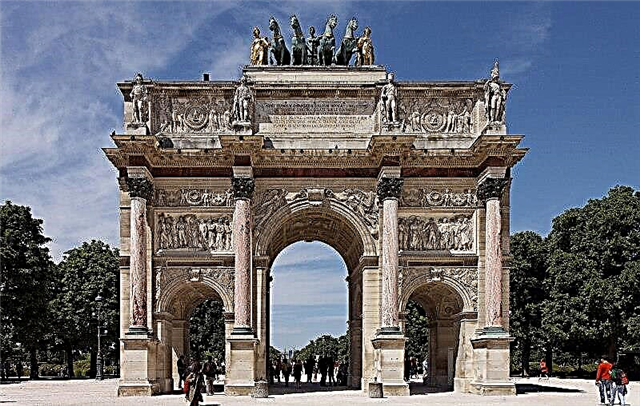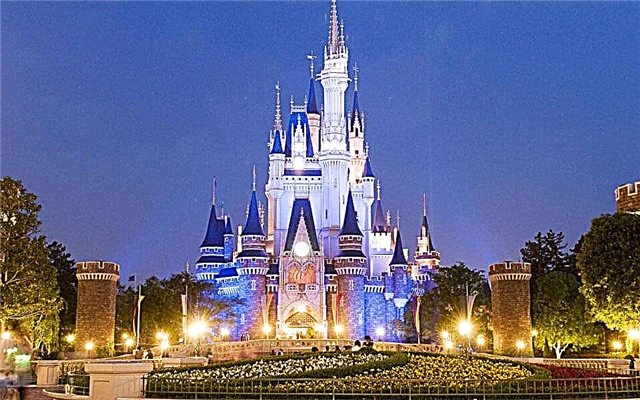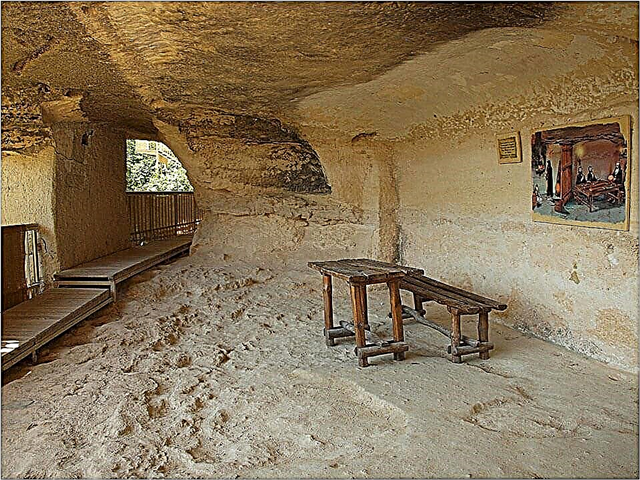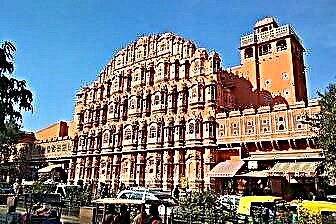Address: Russia, Pskov region, Pskov, on the territory of Pskov Krom
Start of construction: 1682 year
Completion of construction: 1699 year
Project author: master Kirill
Shrines: the relics of the holy noble princes Vsevolod-Gabriel and Dovmont-Timofey, the relics of the blessed Nikolai Salos, the relics of the Monk Martyr Joasaph of Snetogorsk, a particle of the Protection of the Mother of God, the Miraculous icon of the Holy Trinity with acts, the miraculous icon of the Chirskaya Mother of God, the miraculous icon of the Mother of God the icon of the Great Martyr Panteleimon, the icon of the Holy Equal-to-the-Apostles Princess Olga
Coordinates: 57 ° 49'19.5 "N 28 ° 19'44.8" E
Cultural heritage site of the Russian Federation
Content:
The main temple of the Pskov diocese has been standing on the territory of the famous Detinets - the Pskov Kremlin since the end of the 17th century. The five-domed snow-white cathedral became the fourth temple built on this site, and the very first one appeared here in the 10th century, by order of Princess Olga. Today the Holy Trinity Cathedral is the dominant feature of the architectural ensemble of the Kremlin. It has been well restored and welcomes believers and tourists every day.

Cathedral from a bird's eye view
History of the first Trinity Cathedral
The place for the main city church was chosen by Princess Olga herself. She was a native of these lands and visited the city in the middle of the 10th century. The ruler examined Pskov and ordered to build a wooden Holy Trinity Church on the elevated arrow of Velikaya and Pskova, protected by earthen ramparts and palisades. For the construction of the temple, she sent from Kiev "a lot of gold and silver."
The construction of a Christian church in those days is a remarkable fact in itself, because then Christianity did not yet have the status of a state religion. It is not known what the wooden Trinity Church looked like, since neither its descriptions nor images have survived. The first cathedral stood in Except until the 12th century, when it was destroyed by a strong fire.
Second Cathedral
After the fire, it was decided to build a second stone temple. In 1138 it was laid by the grandson of the Kiev prince Vladimir Monomakh - the Novgorod prince Vsevolod Mstislavovich, who is revered by the Church as Saint Vsevolod of Pskov. It is known that the Smolensk architects invited to Pskov built a new cathedral. At that time, the city did not yet have its own builders, and the Pskov architectural school was formed later.

View of the cathedral from the opposite side of the Velikaya river
The second temple became the place where Prince Alexander Nevsky (1242) prayed before the start of the famous Battle on the Ice. This tradition was adopted by other rulers. Pskov occupied a border position and was often in the center of military conflicts, therefore, prayers for the granting of victory to the Pskov army began to be held in the church on a regular basis.
In the main cathedral of Pskov, the conversion to the Orthodox faith of the Lithuanian prince Dovmont took place, who at his baptism took the name Timofey. Later, the prince's sword was kept in the cathedral altar. It, as a symbol of power, was handed over to all the rulers who ascended the Pskov throne. And today this historical relic can be seen in the city museum-reserve.
In the Middle Ages, Vechevaya Square was located in front of the temple, where the main events of the social life of ancient Pskov took place and the veche gathered, which decided the fate of the townspeople. Here they called princes to the Pskov throne and elected mayors. Nearby stood the princely court, in which the city rulers lived. In the basement of the temple, princes, members of their families, and also high priests were buried.

View of the cathedral from the side of the Dovmont tower
At this time, the Holy Trinity Cathedral had a special two-story vestibule - Seni. The facade of the beautiful Senya looked at Veche Square from the south side of the cathedral building. In the narthex, meetings of the State Council were held, and a secular court also worked. In the cathedral, they kept a chronicle, kept the treasury, the state seal and a chest with archival letters and contracts.
Third Cathedral
In 1363, the vault of the dilapidated temple collapsed, and two years later, on the ancient foundation, the third cathedral was built, which was destined to stand for almost 250 years. More information has been preserved about the architecture of the first two stone cathedrals than about the very first church. How they looked can be judged by the images left on ancient icons. They show that the second temple was single-domed, and the third had three chapters.
At the beginning of the 17th century, another devastating fire took place in the city, which also captured the territory of the Kremlin. The cathedral building burned out almost completely. Only the tomb of Prince Dovmont and the relics of St. Vsevolod of Pskov survived. These were difficult times in the history of Russia, when the state suffered from the invasion of the Lithuanian-Polish troops and internal strife. The Russian lands were ruined, there was no money for a major restoration of the cathedral, so the temple was only slightly renovated.

View of the north facade of the cathedral
Fourth Cathedral
In 1682, under Metropolitan Markella, it was decided to build a new cathedral, using the base of the old building and hewn limestone slabs. The construction lasted for 17 long years and was completed in 1699 during the reign of Metropolitan Joseph.
The fourth cathedral was an order of magnitude higher than its predecessor in height and reached 78 m. For that time, it was a very large-scale building, and the high temple was visible from any part of Pskov. It is known from documents of the beginning of the last century that the heads of the Holy Trinity Cathedral were visible from a distance of 56 versts.
A few decades after its construction, the massive structure gave an uneven settlement, so the open galleries on its sides were laid with bricks. And in order to strengthen the temple and prevent its possible destruction, in 1770, buttresses were built around the quadrangle. Then the outer walls of the cathedral were plastered, and it became what we can see it today.
After the coming of Soviet power, the cathedral was given to believers from the schismatic Living Church. In 1935, at the height of the anti-church campaign, the main Pskov church was closed, and an anti-religious museum was set up inside it. Many ancient shrines were placed in the city museum-reserve, and they continue to be kept there today.

View of the cathedral from the opposite side of the Pskov River
Until the beginning of the Great Patriotic War, church services were not held in the cathedral. Then Pskov was occupied by German troops, and in August 1941 the new administration under the auspices of the Pskov religious mission allowed believers to return to the church. Since then, the Trinity Cathedral has never been closed.
Architectural features and interiors
The snow-white cathedral was built in the Russian-Byzantine style. It is based on a six-pillar quadrangle in the shape of a vertically elongated cube. The pillars are supported by supporting arches. At the top of the temple are five massive chapters. It is curious that they are not in the middle, but closer to the eastern part of the cathedral. According to Christian tradition, the five domes are dedicated to Jesus Christ and the four Evangelists. The central chapter of the cathedral is gleaming, while the other chapters are painted gray.
The cathedral building is adjoined by two side-chapels and a closed gallery connected to the narthex. The lower tier, most likely, served as the basement of the old cathedral. Since 1903, it houses a church consecrated in honor of Seraphim of Sarov, and behind its altar there is an ancient tomb. To get to the upper tier, you need to climb the porch and wide stairs.

View of the cathedral from the side of the Great Gate
There is a white bell tower with a clock not far from the cathedral. It appeared later than the cathedral (XVIII century). The tall building is crowned with a pointed spire. The bell tower was built in the traditions of classicism, but, despite this, it forms a harmonious architectural ensemble with the temple.
There are no wall paintings inside the cathedral - they burned down during a fire in the 17th century.However, the interiors of the temple are decorated with a huge iconostasis with gilded carvings. In the cathedral you can see a large modern icon "The Cathedral of the Pskov Saints", which depicts the Christian ascetics of the Pskov lands, headed by Princess Olga.
Current state and visiting regime
The cathedral is open any day from 8.00 to 20.00. Entrance to the territory of Krom and to the cathedral itself is free. Church services are held here twice a day in all four areas - Troitsky, Kazansky, Aleksandrovo-Nevsky and Serafimovsky. Particularly beautiful are the evening services (17.00), when the bishop's choir sings.
In the Holy Trinity Cathedral you can see the relics of Christian saints, a piece of the Protection of the Virgin and icons, the oldest of which were painted in the 16th century. A special place is occupied by the rich crayfish, where the remains of St. Vsevolod of Pskov are kept.
 Cathedral bell tower
Cathedral bell tower
The day of memory of Princess Olga is considered a temple holiday in the cathedral. It is celebrated with a large gathering of people on July 11.
How to get there
The ancient cathedral occupies the central part of the Pskov Kremlin. It is located in the historical center of Pskov, north of the Olginsky bridge across the Velikaya. The territory of the Kremlin has the status of a pedestrian zone, where entry is not allowed for any vehicle. You can get to the Kremlin in the city by buses No. 1, 7, 7A, 11, 15, 18, 19, 25, 30, as well as by minibuses No. 4A, 51, 51A (stop "Lenin Square").











